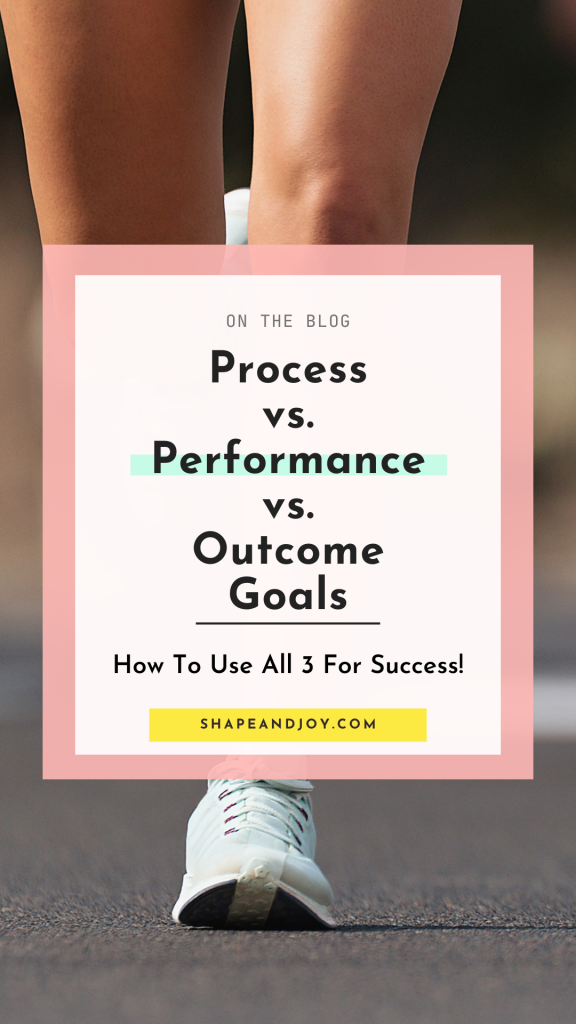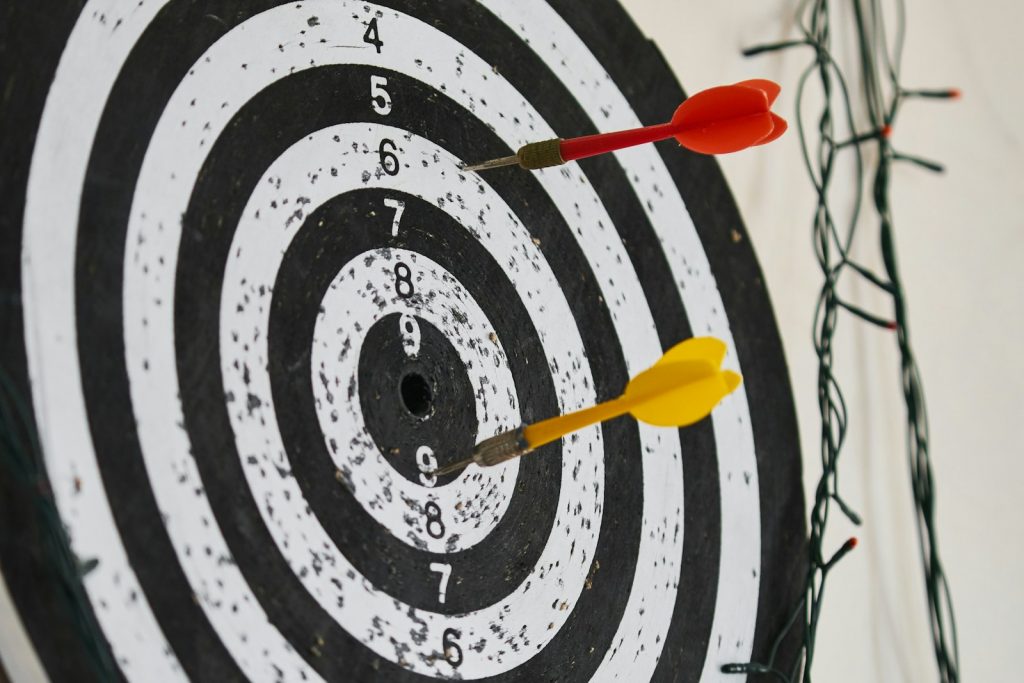This post may contain affiliate links, which means that I may earn a commission if you click on the link, with no cost for you. It’s one of the ways I support my blog. You can read more about this here.
Introduction
Welcome back to our little corner of the internet, where we chat about all things health, fitness, and wellness. I’m so glad you’re here! To start, have you ever set a goal but felt lost on how to achieve it? Trust me, I’ve been there too! It can be so frustrating to have a big dream but not know the steps to make it a reality. Therefore, today, I want to talk about something important that can make a huge difference in your journey towards sustainable weight loss, health, and overall wellness: setting the right types of goals. You see, not all goals are created equal. There are outcome goals, performance goals, and process goals, and each plays a unique role in helping you reach your destination.
Understanding these different types of goals and how to use them can be a game-changer. By the end, you’ll have a clearer picture of how to structure your goals to not only set yourself up for success but also to enjoy the journey along the way.
SEE MY COMPLETE GUIDE ON HABIT FORMATION > Mastering Habit Formation and Behaviour Change For Your Health

Outcome Goals
Outcome goals focus on the end result. For instance, you might aim to lose 20 pounds or run a marathon. These goals are clear and specific. They give you a target to aim for and a reason to keep pushing forward.
Why They Are Important
Outcome goals are important because they give you direction. Specifically, they help you visualise your end destination. This clarity can motivate you and keep you focused. Knowing exactly what you want to achieve will encourage you to take consistent action. Setting specific outcome goals can significantly improve physical activity, weight management, and other health behaviours. (Yumpu)
Examples in Health and Fitness
In terms of weight loss, an outcome goal could be, “I want to lose 20 pounds.” This is a clear and measurable target. In fitness, you might say, “I want to run a marathon.” thus, this gives you a concrete challenge to prepare for.
To succeed, you need the right kind of goals. Check out Setting Goals and Crushing Them for strategies that work.
POSTS YOU MAY BE INTERESTED IN:

Pros and Cons
Benefits:
Outcome goals offer motivation. They give you a clear target to aim for. As a result, this can be very inspiring and keep you committed to your journey.
Potential Downsides:
Outcome goals can feel distant. In other words, the end result might seem far away, making the goal feel overwhelming at times. This can be discouraging if progress seems slow.
Performance Goals
Performance goals focus on achieving specific standards. For example, you might want to run a 10-minute mile. Unlike outcome goals, these goals are about your performance, not just the end result. They measure how well you do something.
How They Differ from Outcome Goals
Performance goals are different from outcome goals as they break down the bigger picture into manageable pieces. While an outcome goal targets the end result, a performance goal targets the steps you take to get there. Therefore, this makes them more actionable and often easier to track.

Examples in Health and Fitness
For weight loss, a performance goal could be, “I will lose 1 pound per week.” This sets a clear, measurable standard for your progress. In fitness, you might set a goal like, “I will improve my squat by 20 pounds in 3 months.” Hence, this gives you a specific performance target to work towards.
POSTS YOU MAY BE INTERESTED IN:
Pros and Cons
Benefits:
Performance goals are more controllable. They focus on what you can do, making them less dependent on external factors. As a result, this can make them feel more achievable and keep you motivated. Setting performance goals significantly enhances the intention-health-behavior relationship (Conner et al., 2016).
Potential Downsides:
Performance goals can still be affected by factors beyond your control. Things like illness, injuries, or unexpected events can impact your ability to meet these goals. Nonetheless, with the right mindset, you can adjust and keep moving forward.
Weight loss goals need to be specific and actionable. Learn more about goal-setting in Smart Weight Loss Goals.
Process Goals
Process goals focus on the actions you take. For instance, going to the gym three times a week. These goals are all about what you do, day in and day out. They help you stay consistent and build healthy habits.
Their Role in Building Habits and Consistency
Process goals are important for creating lasting change. By focusing on daily actions, you build routines that become second nature. Ultimately, this consistency is key to achieving your bigger goals. Over time, these small actions add up to BIG progress.
Examples in Health and Fitness
For weight loss, a process goal could be, “I will track my food intake daily.” This action helps you stay mindful of your eating habits. In fitness, you might set a goal like, “I will follow a workout plan five days a week.” This keeps you committed to your exercise routine. You can use a fitness tracker to keep all your goals in one place, I use this Fitbit Luxe – which I love because it also looks like jewellery!

Pros and Cons
Benefits:
Process goals are fully controllable. You decide to take these actions every day. This control helps you build sustainable habits that support your long-term goals. Moreover, process goals, such as going to the gym regularly, help in forming habits and improving exercise frequency and fitness levels (Prestwich et al., 2003).
Potential Downsides:
Process goals may seem less exciting. They require discipline and can feel repetitive. However, sticking with them is crucial for long-term success.
POSTS YOU MAY BE INTERESTED IN:
- 5 Types Of Mentality: A New Approach To Healthy Habit Changes
- Lose Weight Without The Gym: 15 Easy Habits To Try
- 10 Simple Tricks For Making Exercise A Daily Habit
How to Combine All Three Types of Goals
Effective goal setting involves adjusting between these different types of goals (Wrosch et al., 2013). Each type of goal plays a unique role in your journey. Outcome goals give you a clear target. Performance goals break that target into manageable steps. Process goals focus on the daily actions that ultimately lead to those steps.

Let’s look at an example plan:
- Outcome goal: Lose 20 pounds in 6 months.
- Performance goal: Lose 1 pound per week.
- Process goal: Exercise for 30 minutes, 5 times a week, and track daily food intake.
As a result, this ensures you have a clear end goal, measurable steps, and daily actions to keep you on track.
Tips for Successful Goal Setting
Start small and build up.
First, start small and build up. Initially, begin with small, achievable goals. As you gain confidence, gradually increase your targets. In this way, you prevent overwhelm and it keeps you motivated.
Be flexible and adjust as needed.
Life happens and sometimes plans change. Be ready to adjust your goals if necessary. Indeed, flexibility helps you stay on track without feeling discouraged.
Celebrate small wins to stay motivated.
Take time to celebrate your progress, no matter how small. Recognising your achievements keeps you motivated and reminds you that you’re moving forward.
Consistency turns goals into results. Discover why small habits matter in The Importance of Consistency.
Types of Goals: Conclusion
Outcome goals give you a clear target to aim for. Performance goals break that target into manageable steps. Process goals focus on daily actions to keep you moving forward. Altogether, all 3 types of goals create a well-rounded plan for reaching your health and fitness goals.
Start setting your own goals today! Remember, achieving sustainable weight loss, health, and wellness is a journey, not a race. Take it one step at a time. Be patient with yourself. Celebrate each small win and keep pushing forward. You’ve got this!
I’d love to hear from you! What goals are you setting for yourself? Share them in the comments below. Don’t forget to subscribe to the blog for more tips and support.
Final Note
Thank you so much for joining me on this journey to better health and wellness and I hope you found these tips on setting goals helpful and inspiring. Remember, you’re not alone in this. We’re in it together, cheering each other on every step of the way.
Wishing you all the best in your journey. Stay positive, stay motivated, and enjoy the journey. You’ve got this!
Warmly, Brooke

